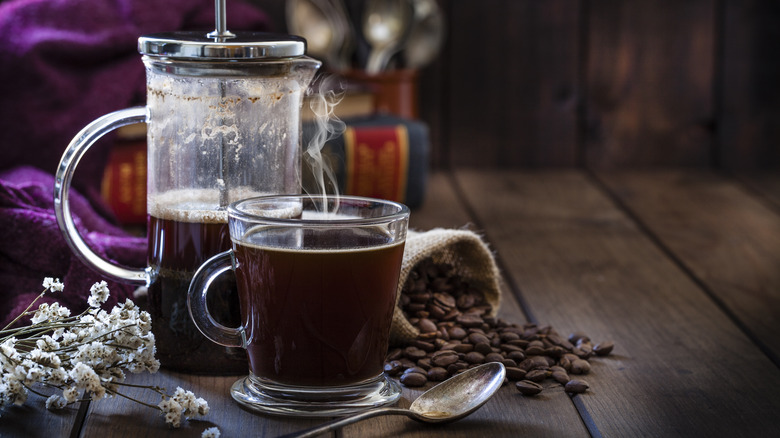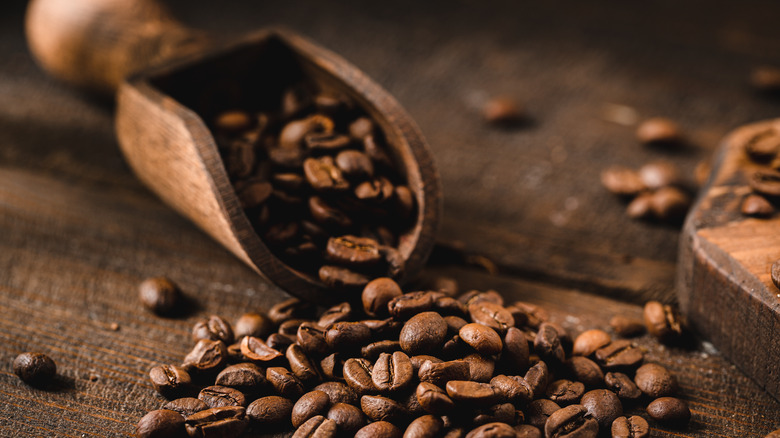The Key To Drinking Coffee Like A Pro Is To Sip It Like Wine
Most Americans drink coffee, and often. According to Statista, a whopping 73.9% of Americans drink coffee every day. But even with the boom in specialty coffee drinks and yearly rage for coffee-spiced confections, for most people, coffee is a matter of convenience above all else. Brewed in a drip coffee maker or poured from a plastic nozzle dispenser at your local gas station, coffee is simply a way of getting a fix of caffeine.
In fact, a hot cup of coffee is the most popular morning drink. But what if that convenience has blunted our enjoyment of that most magical caffeine-filled bean? After all, coffee is a diverse and complex beverage that can be enjoyed in an almost infinite number of ways. And more than ever, coffee is being produced not just for convenience, but for its unique and diverse array of flavor profiles.
The coffee aisle of your grocery store isn't limited to the industrial metal cans that were once the end all be all of coffee consumption. So how can you begin to really appreciate all of these new brews and varieties of coffee? Well, you can start by sipping it as you would your favorite glass of wine.
Making the most of your cup
Getting the most out of your coffee really comes down to a shift in attitude. Instead of blindly drinking from your mug, slow down and take a note from the attentive process of wine tasting. Like wine tasting, there are several aspects of coffee that you'll want to pay attention to. According to experts, there are five things you should consider while enjoying a new brew: sweetness, body, acidity, flavor, and finish, which is also known as aftertaste.
These five characteristics are similar to the five basic tasting characteristics of wine: sweetness, acidity, tannin, alcohol, and body. As with wine, it's important to use every sip to evaluate your drink on each level. Of course, it starts with the first sip, and the variety and preparation of coffee should guide your tasting experience. French press coffee should be left to steep for several minutes before enjoying. Meanwhile, espresso should be enjoyed immediately after pulling a shot. This is because espresso rapidly loses flavor — and its signature crema — minutes after preparation.
Regardless of preparation, the process begins with smell. The smell of coffee is undeniable and variable, and its aroma is a key aspect of its appeal. Taking a moment to smell your freshly brewed coffee will help you to enjoy its unique flavor. Then, of course, comes the sip. And as for that, a good slurping is in order. This will help to splash the drink across your entire mouth and will allow you to fully appreciate its intricate flavors.
Comparing grapes and beans
The similarities between coffee and wine expand far beyond tasting methods. In fact, both beverages include a wide variety of species and classifications. Like wine grapes, which consist of various species, coffee beans are similarly classified. For coffee, there are two main bean types: Arabica and Robusta — and understanding the difference between the two is key.
Arabica beans are used for most specialty coffees and feature a generally low acidity level, and a more subtle and even flavor profile. The taste of Arabica coffee can range from a fruity flavor profile to warm and chocolatey flavors. Robusta, on the other hand, has a higher acidity level. Its robust flavor can tend toward the bitter end of the flavor spectrum. Robusta beans are also quite durable and are able to thrive in unstable climates and growing conditions, which makes it the perfect choice for mass-produced coffee brands such as Maxwell House. Meanwhile, specialty coffee shops such as Starbucks tend to use Arabica beans.
Of course, the level and method of roasting each type of bean also impact its flavor. And, like wine, the specific growing conditions of coffee beans make a difference in your coffee's unique flavor profile. So next time you enjoy a new (or favorite) kind of coffee, approach it as you would a new wine. Drink your cup with care, and look beyond the basics to consider the origins of your beans. It might be your first step in becoming a certified coffee aficionado. Just make sure to not swirl your mug too aggressively — there are some key differences between wine and coffee, after all, and temperature is a big one.


